法律英语——美国房地产交易案例
纽约房屋出售合同范本
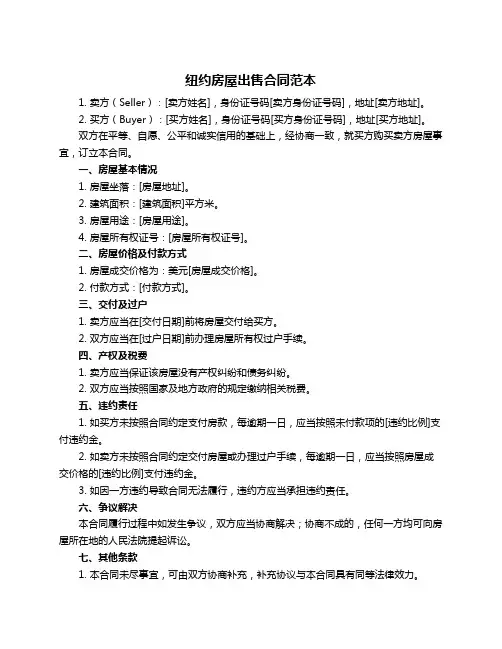
纽约房屋出售合同范本1. 卖方(Seller):[卖方姓名],身份证号码[卖方身份证号码],地址[卖方地址]。
2. 买方(Buyer):[买方姓名],身份证号码[买方身份证号码],地址[买方地址]。
双方在平等、自愿、公平和诚实信用的基础上,经协商一致,就买方购买卖方房屋事宜,订立本合同。
一、房屋基本情况1. 房屋坐落:[房屋地址]。
2. 建筑面积:[建筑面积]平方米。
3. 房屋用途:[房屋用途]。
4. 房屋所有权证号:[房屋所有权证号]。
二、房屋价格及付款方式1. 房屋成交价格为:美元[房屋成交价格]。
2. 付款方式:[付款方式]。
三、交付及过户1. 卖方应当在[交付日期]前将房屋交付给买方。
2. 双方应当在[过户日期]前办理房屋所有权过户手续。
四、产权及税费1. 卖方应当保证该房屋没有产权纠纷和债务纠纷。
2. 双方应当按照国家及地方政府的规定缴纳相关税费。
五、违约责任1. 如买方未按照合同约定支付房款,每逾期一日,应当按照未付款项的[违约比例]支付违约金。
2. 如卖方未按照合同约定交付房屋或办理过户手续,每逾期一日,应当按照房屋成交价格的[违约比例]支付违约金。
3. 如因一方违约导致合同无法履行,违约方应当承担违约责任。
六、争议解决本合同履行过程中如发生争议,双方应当协商解决;协商不成的,任何一方均可向房屋所在地的人民法院提起诉讼。
七、其他条款1. 本合同未尽事宜,可由双方协商补充,补充协议与本合同具有同等法律效力。
2. 本合同一式两份,双方各执一份,具有同等法律效力。
3. 本合同自双方签字(或盖章)之日起生效。
卖方(签字/盖章):__________________买方(签字/盖章):__________________日期:__________________。
美国行政法案例法律英语(3篇)
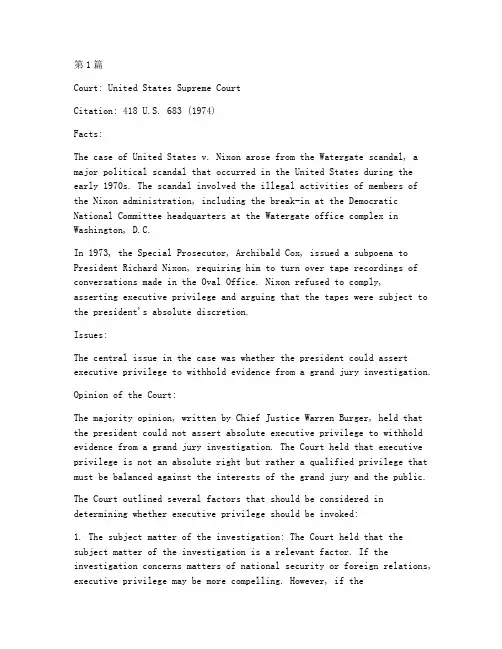
第1篇Court: United States Supreme CourtCitation: 418 U.S. 683 (1974)Facts:The case of United States v. Nixon arose from the Watergate scandal, a major political scandal that occurred in the United States during the early 1970s. The scandal involved the illegal activities of members of the Nixon administration, including the break-in at the Democratic National Committee headquarters at the Watergate office complex in Washington, D.C.In 1973, the Special Prosecutor, Archibald Cox, issued a subpoena to President Richard Nixon, requiring him to turn over tape recordings of conversations made in the Oval Office. Nixon refused to comply,asserting executive privilege and arguing that the tapes were subject to the president's absolute discretion.Issues:The central issue in the case was whether the president could assert executive privilege to withhold evidence from a grand jury investigation.Opinion of the Court:The majority opinion, written by Chief Justice Warren Burger, held that the president could not assert absolute executive privilege to withhold evidence from a grand jury investigation. The Court held that executive privilege is not an absolute right but rather a qualified privilege that must be balanced against the interests of the grand jury and the public.The Court outlined several factors that should be considered in determining whether executive privilege should be invoked:1. The subject matter of the investigation: The Court held that the subject matter of the investigation is a relevant factor. If the investigation concerns matters of national security or foreign relations, executive privilege may be more compelling. However, if theinvestigation concerns internal executive branch matters, executive privilege may be less compelling.2. The need for the evidence: The Court held that the need for the evidence is a relevant factor. If the evidence is essential to the investigation, executive privilege may be less compelling.3. The degree to which the evidence is relevant: The Court held that the degree to which the evidence is relevant is a relevant factor. If the evidence is highly relevant, executive privilege may be less compelling.4. The degree to which the evidence has been previously disclosed: The Court held that the degree to which the evidence has been previously disclosed is a relevant factor. If the evidence has been previously disclosed, executive privilege may be less compelling.Reasoning:The Court relied on several precedents to support its decision. It cited United States v. Nixon, 418 U.S. 683 (1974), which held that the president could not claim executive privilege to withhold evidence from a grand jury investigation. The Court also cited separation of powers principles, arguing that the independence of the executive and judicial branches requires that the president not be able to use executive privilege to obstruct the judicial process.The Court further held that executive privilege is not absolute because it would undermine the rule of law and the independence of the judicial branch. The Court argued that the grand jury is an independent body that must be free to investigate criminal conduct without interference from the executive branch.Significance:The case of United States v. Nixon is one of the most significant Supreme Court decisions concerning executive privilege. It established the principle that executive privilege is not absolute and that it must be balanced against the interests of the grand jury and the public.The case also had a significant impact on the Watergate scandal. The Supreme Court's decision forced President Nixon to comply with the subpoena and turn over the tape recordings, which ultimately led to his resignation.Discussion:The case of United States v. Nixon raises several important questions about the scope of executive privilege and the balance between the powers of the executive and judicial branches. While the Court held that executive privilege is not absolute, it also recognized that the president must have some degree of discretion to protect sensitive information.One potential criticism of the Court's decision is that it may have weakened the president's ability to protect national security information. However, the Court's decision was based on the specific facts of the case and the need for the evidence in the grand jury investigation.Another criticism is that the Court's decision may have set a precedent for other cases involving executive privilege. This could lead to increased judicial oversight of executive branch actions and potentially undermine the separation of powers.In conclusion, the case of United States v. Nixon is a landmark decision that has had a significant impact on the balance of power between the executive and judicial branches. It establishes that executive privilege is not absolute and that it must be balanced against the interests of the grand jury and the public. The case remains a relevant and important topic of discussion in American constitutional law.Footnotes:1. United States v. Nixon, 418 U.S. 683 (1974).2. Archibald Cox was appointed as the Special Prosecutor to investigate the Watergate scandal.3. Executive privilege refers to the president's right to withhold certain information from the public and other branches of government.4. The rule of law refers to the principle that all individuals and institutions are subject to and accountable to laws that are publicly promulgated, equally enforced, and independently adjudicated.5. The separation of powers refers to the division of government into different branches, each with its own powers and responsibilities.6. The balance of power refers to the distribution of power among different branches of government to prevent any one branch from becoming too powerful.7. The executive branch is responsible for enforcing the laws and administering the government.8. The judicial branch is responsible for interpreting the laws and resolving disputes.9. The legislative branch is responsible for making the laws.10. The grand jury is a group of citizens who are empaneled to investigate whether there is sufficient evidence to charge a person with a crime.第2篇IntroductionThe case of United States v. Nixon (1974) is one of the most significant cases in American administrative law. This landmark case revolves around the issue of executive privilege and its limitations in the context of the Watergate scandal. The Supreme Court's decision in this case has had a profound impact on the balance between executive power and the rule of law in the United States. This article will discuss the facts of the case, the legal issues involved, and the Supreme Court's decision.Facts of the CaseIn 1972, a break-in was discovered at the Democratic National Committee headquarters at the Watergate Hotel in Washington, D.C. Theinvestigation revealed that several of the individuals involved in the break-in were connected to the Nixon administration. The Watergate scandal led to numerous investigations and inquiries, including a special Senate committee and a grand jury investigation.During the course of the investigation, the special prosecutor, Archibald Cox, requested that President Richard Nixon release tape recordings of conversations that occurred in the Oval Office. The president refused to comply with the request, claiming executive privilege, which is the right of the president to withhold certain information from Congress or the courts.Legal IssuesThe central legal issue in the case was whether the president's claim of executive privilege was valid and whether it could be invoked to prevent the release of the tape recordings. The Supreme Court had to consider several questions:1. Does the president have executive privilege?2. If so, is executive privilege absolute or does it have limits?3. Does the executive privilege extend to the president's personal conversations?The Supreme Court's DecisionIn a 7-2 decision, the Supreme Court held that the president does have executive privilege, but that it is not absolute. The Court emphasized that executive privilege is a necessary component of the separation of powers and allows the president to carry out his duties without interference from the other branches of government.However, the Court held that executive privilege is not absolute and must be balanced against the public interest. In this case, the Court concluded that the public interest in uncovering the truth about theWatergate scandal outweighed the president's claim of executive privilege.The Court further held that the executive privilege does not extend to the president's personal conversations. The Court stated that the privilege is meant to protect the confidentiality of official communications, not the president's personal thoughts and feelings.Impact of the DecisionThe decision in United States v. Nixon has had a significant impact on American administrative law. It has established that executive privilege is not an absolute right and that it must be balanced against the public interest. This has implications for other cases involving executive privilege, such as the release of classified information or the investigation of governmental misconduct.Moreover, the case has reinforced the principle that the rule of law is paramount and that no individual, including the president, is above the law. This has been a crucial factor in maintaining the integrity of the democratic process and ensuring that the government operates within the bounds of the law.ConclusionThe case of United States v. Nixon is a landmark case in American administrative law. It highlights the importance of balancing executive power with the rule of law and underscores the principle that no individual is above the law. The Supreme Court's decision has had a lasting impact on the administration of justice in the United States and continues to be a relevant precedent in cases involving executive privilege and governmental misconduct.第3篇Case BriefCase Name: City of Boston v. EPACitation: 868 F.2d 896 (1st Cir. 1989)FactsThe City of Boston, Massachusetts, sought to reduce its emissions of sulfur dioxide (SO2) to comply with the Clean Air Act of 1970. To achieve this goal, Boston proposed to implement a cap-and-trade program, which would allow the city to purchase allowances from other sources to cover its excess emissions. The United States Environmental Protection Agency (EPA) denied Boston's proposal, claiming that it was not in compliance with the Clean Air Act. Boston challenged the EPA's decision in court.IssueWhether the EPA's decision to deny Boston's proposal to implement a cap-and-trade program was arbitrary and capricious, and therefore, an abuse of discretion.HoldingThe court held that the EPA's decision to deny Boston's proposal was not arbitrary and capricious, and therefore, not an abuse of discretion.RationaleThe court began by noting that the EPA has broad discretion in interpreting and enforcing the Clean Air Act. In this case, the EPA concluded that Boston's proposal was not in compliance with the Act because it would not achieve the necessary reductions in SO2 emissions. The court agreed with the EPA's interpretation of the Act and found that the agency's decision was based on substantial evidence.The court also considered whether the EPA's decision was arbitrary and capricious. The court held that the EPA's decision was not arbitrary and capricious because it was based on a reasonable interpretation of the Clean Air Act and was supported by substantial evidence. The court emphasized that the EPA's decision was not motivated by improper considerations and that the agency had carefully considered the arguments presented by Boston.Finally, the court addressed whether the EPA's decision was an abuse of discretion. The court held that the EPA's decision was not an abuse of discretion because it was within the agency's authority to interpret and enforce the Clean Air Act. The court also noted that the EPA's decision was in the public interest, as it was designed to ensure that Boston's emissions were reduced to the levels required by the Act.DiscussionThe City of Boston v. EPA case is an important example of the deference that courts afford to administrative agencies in interpreting and enforcing complex environmental regulations. The case highlights the broad discretion that agencies have in making decisions regarding compliance with environmental laws and the deference that courts give to those decisions.The court's decision in this case is consistent with the principle that administrative agencies are experts in their respective fields and should be given considerable latitude in interpreting and enforcing complex regulations. However, the court also emphasizes that agencies must act within the scope of their authority and cannot base their decisions on improper considerations.The case also raises important questions about the role of cap-and-trade programs in environmental regulation. While cap-and-trade programs can be an effective tool for reducing emissions, they must be designed and implemented in a manner that is consistent with the requirements of the Clean Air Act. The court's decision in this case suggests that agencies must carefully consider the impact of cap-and-trade programs on compliance with environmental regulations before approving such programs.ConclusionThe City of Boston v. EPA case is an important example of the deference that courts afford to administrative agencies in interpreting and enforcing complex environmental regulations. The case highlights the broad discretion that agencies have in making decisions regarding compliance with environmental laws and the deference that courts give tothose decisions. The case also raises important questions about the role of cap-and-trade programs in environmental regulation, emphasizing the need for careful design and implementation to ensure compliance with environmental laws.。
纽约房屋出售合同范本
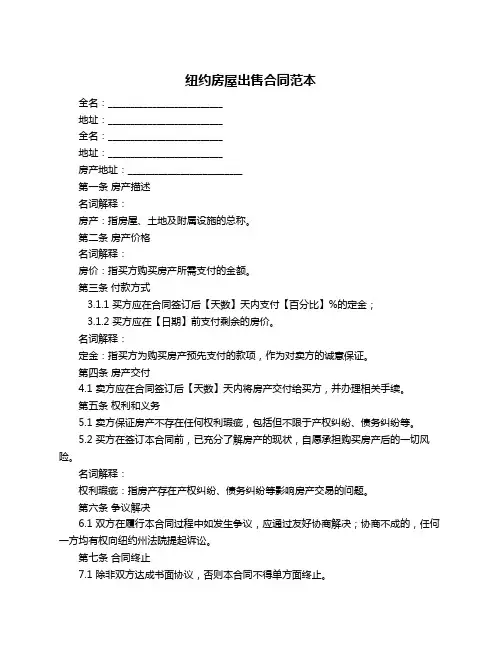
纽约房屋出售合同范本全名:__________________________地址:__________________________全名:__________________________地址:__________________________房产地址:__________________________第一条房产描述名词解释:房产:指房屋、土地及附属设施的总称。
第二条房产价格名词解释:房价:指买方购买房产所需支付的金额。
第三条付款方式3.1.1 买方应在合同签订后【天数】天内支付【百分比】%的定金;3.1.2 买方应在【日期】前支付剩余的房价。
名词解释:定金:指买方为购买房产预先支付的款项,作为对卖方的诚意保证。
第四条房产交付4.1 卖方应在合同签订后【天数】天内将房产交付给买方,并办理相关手续。
第五条权利和义务5.1 卖方保证房产不存在任何权利瑕疵,包括但不限于产权纠纷、债务纠纷等。
5.2 买方在签订本合同前,已充分了解房产的现状,自愿承担购买房产后的一切风险。
名词解释:权利瑕疵:指房产存在产权纠纷、债务纠纷等影响房产交易的问题。
第六条争议解决6.1 双方在履行本合同过程中如发生争议,应通过友好协商解决;协商不成的,任何一方均有权向纽约州法院提起诉讼。
第七条合同终止7.1 除非双方达成书面协议,否则本合同不得单方面终止。
第八条合同效力8.1 本合同自双方签字盖章之日起生效,一式两份,双方各执一份。
卖方(签名):__________________________ 日期:____年____月____日买方(签名):__________________________ 日期:____年____月____日。
详解美国房地产法的规定与操作
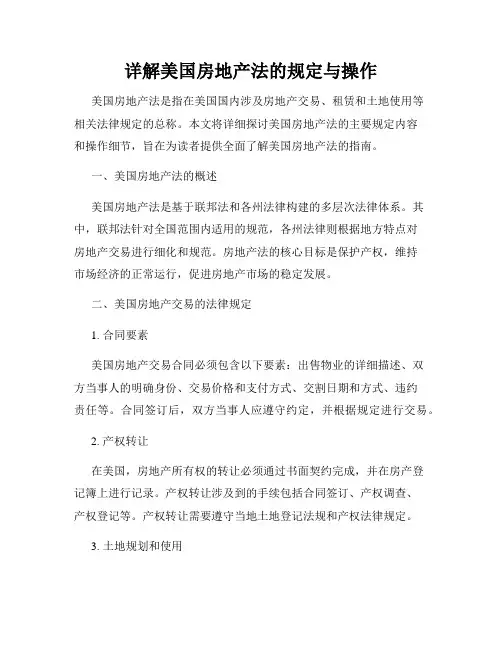
详解美国房地产法的规定与操作美国房地产法是指在美国国内涉及房地产交易、租赁和土地使用等相关法律规定的总称。
本文将详细探讨美国房地产法的主要规定内容和操作细节,旨在为读者提供全面了解美国房地产法的指南。
一、美国房地产法的概述美国房地产法是基于联邦法和各州法律构建的多层次法律体系。
其中,联邦法针对全国范围内适用的规范,各州法律则根据地方特点对房地产交易进行细化和规范。
房地产法的核心目标是保护产权,维持市场经济的正常运行,促进房地产市场的稳定发展。
二、美国房地产交易的法律规定1. 合同要素美国房地产交易合同必须包含以下要素:出售物业的详细描述、双方当事人的明确身份、交易价格和支付方式、交割日期和方式、违约责任等。
合同签订后,双方当事人应遵守约定,并根据规定进行交易。
2. 产权转让在美国,房地产所有权的转让必须通过书面契约完成,并在房产登记簿上进行记录。
产权转让涉及到的手续包括合同签订、产权调查、产权登记等。
产权转让需要遵守当地土地登记法规和产权法律规定。
3. 土地规划和使用土地规划和使用需要遵循相关法律法规,包括建筑规定、土地用途规划和规范等。
在美国,根据地方性的特点,不同城市和州对土地的规划和使用有所不同,因此在进行土地开发和建设时,需要遵循当地的具体规定。
三、美国房地产交易的操作细节1. 房产调查在购买房产之前,买方应进行相关的房产调查,了解房产的历史、产权状况以及潜在的法律问题。
房产调查的内容包括房产报告、产权证明、土地权属调查等。
通过房产调查,买方可以确保所购房产的合法性和真实性。
2. 贷款申请购房者常常需要贷款来购买房产。
在美国,购房者可以向银行或其他金融机构申请房屋贷款。
贷款申请需要提供个人信息、房产信息、财务状况等必要材料,并接受信用调查。
贷款申请成功后,购房者可以支付一定的首付款,并按照合同规定的期限和方式偿还贷款。
3. 房地产交割交割是房地产交易中的重要环节,也是最后确认所有权转移的过程。
纽约房产投资合同模板
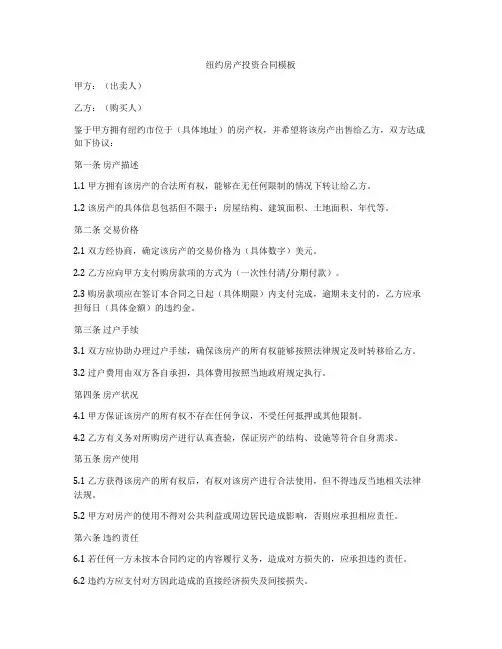
纽约房产投资合同模板甲方:(出卖人)乙方:(购买人)鉴于甲方拥有纽约市位于(具体地址)的房产权,并希望将该房产出售给乙方,双方达成如下协议:第一条房产描述1.1 甲方拥有该房产的合法所有权,能够在无任何限制的情况下转让给乙方。
1.2 该房产的具体信息包括但不限于:房屋结构、建筑面积、土地面积、年代等。
第二条交易价格2.1 双方经协商,确定该房产的交易价格为(具体数字)美元。
2.2 乙方应向甲方支付购房款项的方式为(一次性付清/分期付款)。
2.3 购房款项应在签订本合同之日起(具体期限)内支付完成,逾期未支付的,乙方应承担每日(具体金额)的违约金。
第三条过户手续3.1 双方应协助办理过户手续,确保该房产的所有权能够按照法律规定及时转移给乙方。
3.2 过户费用由双方各自承担,具体费用按照当地政府规定执行。
第四条房产状况4.1 甲方保证该房产的所有权不存在任何争议,不受任何抵押或其他限制。
4.2 乙方有义务对所购房产进行认真查验,保证房产的结构、设施等符合自身需求。
第五条房产使用5.1 乙方获得该房产的所有权后,有权对该房产进行合法使用,但不得违反当地相关法律法规。
5.2 甲方对房产的使用不得对公共利益或周边居民造成影响,否则应承担相应责任。
第六条违约责任6.1 若任何一方未按本合同约定的内容履行义务,造成对方损失的,应承担违约责任。
6.2 违约方应支付对方因此造成的直接经济损失及间接损失。
第七条法律适用及争议解决7.1 本合同的订立、生效、履行、解释及争议的解决均适用纽约州法律。
7.2 若双方在履行本合同过程中发生争议,应尽量友好协商解决;协商不成的,应提交至当地仲裁机构或法院解决。
第八条其他8.1 本合同自双方签字盖章之日起生效,至双方履行完毕合同义务终止。
8.2 本合同正本一式(具体份数),每方各执一份,具有同等效力。
甲方(盖章):乙方(盖章):签订日期:签订日期:。
美国房地产合同中的 Escrow Deposit

美国房地产合同中的Escrow DepositEscrow 用土话来说就是保证金。
在美国房地产交易中可能有2 个地方涉及到Escrow 的定义。
第一类就是房地产合同中的Escrow 定义第二类就是房地产贷款中的Escrow 账号的定义。
在第二个定义,我们统称为Escrow Account,土话来说就是保证金账号,这个账号统称是由金融系统来设置的,包括有贷款公司,银行等。
有关贷款公司,银行等金融机构使用的保证金账户,请参考:美国房地产交易中贷款的美国房地产交易中贷款的 Escrow Account页面中的内容。
因为我们在这里讨论的是房地产合同中的Escrow ,其实就是针对的第一类,这类是你在于房地产经纪公司进行交易和处理的时候需要涉及到的,不涉及第二类。
合同中Escrow 定义合同中Escrow 的定义就是在房地产进行交易的是买家需要存入的保证金。
通常就是当合同在双方都签字后,买家需要在一定的时间内将一定金额存入到房地产经纪公司。
这个房地产经纪公司可以是买家的房地产经纪公司,也可以是卖家的房地产经纪公司。
一般来说为了方便都会存入卖家的房地产经纪公司,以保障房地产销售合同的正常执行。
保证金存多少需要存的保证金在合同设立的时候就已经在合同中说明了。
具体金额没有约束,你可以存100 美元,你也可以存100 万美元,这些都是没有关系的。
一般来说会在1000 美元到1 万美元之间。
一般来说见过比较多的都是5000,8000,1 万这种的保证金,比较难看到超过1 万的。
其实这个保证金多少意义并不是非常大,因为在合同执行后买家以其他理由拿回去而不接受惩罚。
常见的理由就是贷款不能获批,房屋检查出现了不可以接受的问题,或者买家通过房屋检查后不愿意继续执行等等。
存多一点,最多表示在提交Offer 的一种诚意罢了,以便于卖家更加倾向选择你的合同。
什么时候存入在合同双方签字生效后的3 到5 天。
一般来说这个存入时间都会在合同中说明的,基本上是3 到5 给到房地产经纪公司即可。
美国房屋小销售签订合同
甲方(卖方):_________________________乙方(买方):_________________________根据《中华人民共和国合同法》及相关法律法规的规定,甲乙双方在平等、自愿、公平、诚实信用的原则基础上,就甲方将其位于美国的一处房屋出售给乙方,达成如下协议:一、房屋基本情况1. 房屋地址:_________________________2. 房屋产权证号:_________________________3. 房屋面积:_________________________4. 房屋结构:_________________________5. 房屋用途:_________________________6. 房屋现有装修情况:_________________________二、房屋售价1. 乙方同意购买甲方上述房屋,成交价格为:美元(USD)_________________________(大写:_________________________)2. 甲方保证所售房屋产权清晰,不存在任何权属纠纷。
三、付款方式1. 乙方应在签订本合同之日起____个工作日内,将房屋成交价格的_____%(即:_________________________)支付给甲方。
2. 乙方支付定金后,甲方应向乙方提供房屋产权证、房屋买卖合同等相关文件。
3. 乙方支付剩余房款的方式如下:(1)乙方在签订本合同之日起____个工作日内,将房屋成交价格的_____%(即:_________________________)支付给甲方。
(2)乙方在办理房屋过户手续前,将房屋成交价格的_____%(即:_________________________)支付给甲方。
(3)乙方在办理房屋过户手续后,将房屋成交价格的_____%(即:_________________________)支付给甲方。
四、房屋过户1. 甲方应在本合同签订之日起____个工作日内,协助乙方办理房屋过户手续。
法律英语
Lien 留置权
这是扣留他人财物的权利,一般用作为还款的保证,或者作为还款的交换。
Limitation period时限
民事申索案件,一般都有一个指定的时限,时限过后,必须要得到法庭的特别批准,才可以进行有关的申索或者程序。一般的合约纠纷时限为6年,但涉及契约的纠纷则有12年时限,雇员工伤索偿的时限是由意外发生日起的两年内进行,而其它受伤索偿的时限则有3年。
Lapse 失去时效
在商议的过程中,所给予考虑的时限过后,有关的提议也失去了效力。例:This offer will be lapsed automatically after the time limit. 这项要约在期限过后,便会自动失效。
Leave 许可
Leave这个词一般解作“离去”,但法律上则用作为法庭的许可,例:It is necessary to seek the Court’s leave to file a document out of time. 时限过后,必须得到法庭的许可才可以将文件存盘。
裁定书 order; ruling; determination(指终审裁定)
裁决书 award(用于仲裁)
裁决书 verdict(用于陪审团)
采信的证据 admitted evidence; established evidence
草拟股权转让协议 drafting agreement of assignment of equity interests
From: /word/falv/2007-09-19/13905.html
案件受理费 court acceptance fee
案情重大、复杂 important and complicated case
美国加州住房买卖合同
美國加州住家購房合同買賣說明書出价:要求填写买主的姓名及其他任何将成为屋主的姓名。
在这段中也要写明地产的地址﹐愿意出的价钱和买主希望何时“交屋”﹐换言之﹐买主何时愿意付款拥有此屋。
财务安排:解释买主将怎么样付款。
大部分的买主在事前付些“订金”。
“房屋代书”是指一间不受买主或卖主影响的中立公司(俗稱:ESCROW)﹐他们会为买主保管订金。
在这一段里买主也可标明是否需要贷款﹐(如果需要贷款﹐要贷多少金额)﹔或者买主是否将以其他已有款项购屋.买卖完成与交屋:说明买主何时会搬进住屋﹐卖主何时应该迁出。
如果目前仍有房客居住﹐则需注明现有房客将怎样安置﹐并可在此段注明买主何时可以取得钥匙。
费用分担与支付:写出买主或卖方谁将付那些买卖房屋的手续费。
例如﹕房地产附近的环境(房子是否位在容易发生地震﹐火灾﹐和水灾的地区)报告费﹐产权保险费﹐代书公司手续费﹐地价税﹐或其他政府费用。
法定的报备声明(包括含铅油漆的告知)以及取消合约的权力:注明法律所规定卖方必须书面告知买主的一些事项。
例如﹕房屋的油漆是否含铅﹐房子是否在地震带或是容易发生火灾和水灾的地区﹐和卖方所知房屋有问题的地方。
一般来说﹐买方如果不喜欢任何一项声明﹐买主有数天的时间可以考虑取消合约(大約在17天內)﹐并取回全部的订金。
集合住宅(康斗)/拟定单位开发报备声明: 指出当房屋受到某些规定的管辖时﹐卖主必须提供买主额外的资料。
例如﹕如果房子是集合住宅(康斗)或其他屋主共用游泳池或会议室等这类的已定条文约定。
影响房屋的状况:说明交屋时﹐房屋应是买主在签合同时的状态。
卖主不需整修任何已经损坏的东西。
可是卖主必须要告诉买主任何卖主已知有损坏的部份﹐并应负责修复双方已签约后才损坏的任何部份。
这一段也提醒买主﹐买主有权“检验”欲购房屋。
如果检查后有不满的地方﹐买主可以取消合同﹐或者他或她可以要求卖主整修。
虽然卖主不必修复全部的问题﹐如果买主提出要求后卖主拒绝整修﹐买主有权取消合同﹐并取回订金。
法律英语阅读理解:The Law of Property财产法-最新范文
法律英语阅读理解:The Law of Property财产法The old common law1 was preeminently the law of real property; and the distinction between “real property” and “personal property3” was a crucial one.Generally speaking, real property means real estate -1and and buildings ——but it also includes such things as growing crops. Everything else —— money, stocks and bonds, jewelry, cars, carloads of lumber, IOUs, bank deposits- is personal property. We all have a stake in real estate, since we all live somewhere; and we work, study, and travel somewhere, too. Everyone is a renter or an owner, or lives with renters or owners. But for most of us, that as far as the law is concerned the word property means primarily real property; personal property is of minor importance.Actually, personal property is legally a minor field. There is no single, special field of law devoted to personal property. Personal property is what contract law, commercial law, and bankruptcy law ——yes, and torts, too ——are all about. But there are so many special rilles about real estate that it makes sense to treat this as a separate field of law.Property law is still one of the fundamental branches of law, and real estate is a significant branch of law practice.Yet property law is a mere shadow of its former self, legal speaking. In fact, one of the major developments in our system, if you take the long view, is the relative decline of real property law. In medieval England, it would have only been a slight exaggeration to say that land law was the law of the land. When Blackstone published his “Commentaries” midway through the eighteenth century, one whole volume was devoted to land law. A modern Blackstone would shrink the topic to a fraction of this bulk —— 5 or 10 percent, at most, of the total law.Medieval England lived under a feudal system. Power and jurisdiction —— the cornerstones of wealth and position in society were based on land and land alone. The “lord” was a person who held an estate ——a person with ownership, mastery, control over land. A person without land was a person with no real stake in affairs of state. The common law, as the royal law courts expounded it had little to say to men and women without land, who were the majority of the English population. In America, at one time, only persons who had interests in land were entitled to vote or hold office. The New York constitution of 1777, for example, restricted the right to vote for state senators to men who owned “freeholds” with $100or more, free and clear of debt (Article X) all this, of course, has ended;land is only one form of wealth. A great and powerful family is one that controls mighty enterprises, rather than one that rules vast estates.Property law still covers a rich and varied group of subject. To begin with, it asks. What does it mean to “own” land? How can I get title to land and how can I dispose of it legally?There are issues about deeds, joint ownership, and land records and registration; and problems of land finance, including rules about mortgages and foreclosures. There is the law of “nuisance”, which restricts me from using my land in such a way as to hurt my neighbors, pouring smoke or sending bad smells onto his land, for example. Ther e are the law of “easements” and the exotic law of “covenants” (especially those that “run with the land”): these deal with rights a person might have in his neighbor’s land —— rights to drive a car up his driveway, to walk across his lawn, or to keep him from taking in boarders. These are not rights of ownership; rather they are “servitudes” ——restrictions or exceptions to the owner’s rights, in favor of those another.The common law was ingenious in carving up rights to land into variou s complex segments called “estates”。
- 1、下载文档前请自行甄别文档内容的完整性,平台不提供额外的编辑、内容补充、找答案等附加服务。
- 2、"仅部分预览"的文档,不可在线预览部分如存在完整性等问题,可反馈申请退款(可完整预览的文档不适用该条件!)。
- 3、如文档侵犯您的权益,请联系客服反馈,我们会尽快为您处理(人工客服工作时间:9:00-18:30)。
Real Estate Sales Contract
Date: Nov.5th AGREEMENT made by and between John and Sara Buchanan, Hereinafter called Seller, Whose address is 272 Moody Street, Watertown, agrees to sell to Sam and Tina Ford, Hereinafter called Buyer, Whose address is 1743 Main Street, Watertown.
Dear Mr. Simkin: You have requested our advice regarding the recourse of the breach of the sale contract between you and Mr. Barnes. This letter is furnished by us as general counsel to you. From the materials we have, the fact that the buyer informed the seller in writing that he wouldn’t perform the contract constitutes anticipatory repudiation. Dealing with anticipatory repudiation, our advices are as follows: Find a new buyer to enter into a new contract, and claim a damage which recover the difference between resale price and the contract price. And you can keep the $5,000 earnest money. It is remarkable that the damage you claimed plus earnest money should not exceed the amount of contract price. Or you can bring a specific performance suit against the buyer, but only if the buyer is enforceable. That is to say, if the buyer is insolvent, the specific performance suit against him is inappropriate. The most important thing is time. If the market price goes down continuously, you should find a new buyer ASAP. Because in the event of excessively low market price, you can’t claim all the damage due to the unforeseeability of the damage. Another thing you need to pay attention to is the status of buyer. Never be blind to the high price offer. Check out the new buyer’s purchasing power, financial status if necessary. If the price is tremendously high, you should be cautious. This opinion is given for your sole benefit and may not be disclosed or relied upon by any other person without our prior written consent. Very truly yours
Finished on October 8th Revised on Decemeber 10th
Quinn Young
Legal Opinion
Date: December 10, 2011 To: Harold Simkin From: Quinn Young Subject: the recourse of the breach of the sale contract
Dear Mr. Buchanan: You have requested us to draft a contract of sale for you about the real estate transaction between you and the Fords. The sample contract is annexed below. I’ll let you know something important. First, a quick sale is what you want, so time limits for every sale stage is necessary. You’d better make a schedule about your move and job, then set several time limits to the buyer. Second, a smooth sale is preferable, so avoid all the risks is important. As for your situation, risks lie in default of buyer both in this contract and his sales contract, buyer’s failure to get a financing, and so on. Some measures should be taken: (a) earnest money clause is a method to increase the cost of buyer’s default; (b) get a copy of buyer’s sale contract to know whether there is a snake in the grass; (c) ask buyer to get a commitment letter issued by bank which can prove buyer’s ability to get finance; (d) a specific allocation of risks clause. Third, more profitable is better. Buyer wants to move into the house before closing, you can either make a license or lease it to the buyer, which can require an additional charge. The advantage is the house is under care of the buyer before closing. The disadvantage is the disclosure of more and more old house’s defects, which may decrease the price of the house. At last, if the buyer fails to get a finance, seller finance may be accessible. Seller finance means the buyer will make some sort of down payment to the seller, and then make installment payments (usually on a monthly basis) over a specified time, at an agreed-upon interest rate, until the loan is fully repaid.
Finished on October 15th Revised on Decemeber 16th
Quinn Young
Legal Opinion
Date: December 16, 2011 To: John and Sara Buchanan From: Quinn Young Subject: sales contract of Buchanan’s propert notices and communications required to be given herein shall be sent to the parties listed above at their respective addresses by certified mail-return receipt
2. TERMS:
Buyer shall pay for the Property the sum of $127,500 payable as follows: (a) The sum of $ 10,000 as Earnest Money, receipt of which is hereby acknowledged, and upon acceptance in writing and delivery of this Contract, the Earnest Money shall be assigned to and deposited in the trust account of Listing Broker to be applied on the purchase price and closing costs, if any, at the time of Closing; (b) At Closing, IN CASH OR CERTIFIED FUNDS, the further sum of $5,500 down payment; and (c) Loan(s), in the sum of $102,000 set forth in the attached Supplemental Financing Agreement.
